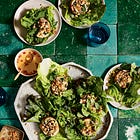As of last summer, I have gone what I call “98% vegetarian,” meaning I don’t eat meat other than oysters, mussels, and clams (I follow the “no eyes” rule, though I do eat potatoes, in case you were wondering), or other things under circumstances that are too complicated to explain but rare enough that they almost never come up. After more than 50 years of omnivorism, and because—finally being an independent operator whose focus is almost entirely on a meatless food—I no longer needed to cook or eat meat for work, I decided I’d eaten enough meat for a single lifetime. My reasons for doing so include all of the usual suspects: animal welfare, environmentalism, personal health, take your pick.
The transition away from eating meat has not really been all that hard, except maybe for my wife, who has had it thrust upon her involuntarily, since I do most of the cooking around the house. I happen to love beans, for starters. And I quickly discovered that I very much enjoyed the challenge of recreating my favorite meat recipes (including many of my own that I’d developed for other venues) without the meat. Nine times out of ten this involves swapping out the meat for beans (usually chickpeas), tofu, or mushrooms. I almost never reach for faux meat products, which—however better they are for the animals they are meant to recreate—are hardly virtuous when it comes to resource intensity. And most of them aren’t all that enjoyable to me. (I’ll eat an Impossible Burger at a restaurant if there’s no other decent vegetarian option, but I also probably won’t frequent that restaurant again.)
While I’ve figured out much of this by experimentation, I’ve been aided by a stack of excellent recently-published cookbooks on vegetarian or vegan cooking, particularly cuisine-specific ones. The latest of these is Ever-Green Vietnamese, the new book from my friend and favorite authority on Asian and Vietnamese cooking, Andrea Nguyen.

As a bone fide national treasure, Andrea probably needs no introduction, but in case you aren’t already a fan, she is the author of seven cookbooks, including Into the Vietnamese Kitchen, Asian Tofu, and Asian Dumplings, head honcho of the long-running blog on Asian and Vietnamese cooking, Viet World Kitchen, and, most recently, the author of the similarly-themed Substack newsletter, Pass the Fish Sauce. (She’s also one-quarter of the team behind one of my favorite podcasts, Everything Cookbooks, a resource that has been a balm and an encouragement as I toil away on my own.)

Ever-Green Vietnamese is not a vegetarian book, since it does include some meat-containing recipes here and there, but it is so vegetable-forward that it is at least 98% vegetarian, which makes it perfect for me. It is also an exploration of how Vietnamese cooks elevate vegetables to the center of the plate, in ways that make them just as satisfying as meat, which makes it perfect for everyone.
Here’s how Andrea describes the book and its inception on her newsletter:
Ever-Green Vietnamese started in late 2019 when I had a health scare and needed to change my diet. The solution came from doubling down on vegetables, but not giving up animal protein altogether. In exploring the potential of the plant kingdom in the Vietnamese kitchen, I gained even greater appreciation for how vegetables may star in enticing, remarkable food…
I wasn't cooking deprivation dishes but rather, celebration dishes. I realized that the food I was making reflected the enduring, evergreen philosophy of Vietnamese cooking, which has always been rooted in the plant kingdom with some seafood and a little meat playing co-starring roles. And because that plant-focused philosophy is also sustainable—just commit to more plants and less (not necessarily no) meat and you'll also be doing good for the planet—the book was titled Ever-Green Vietnamese.
I wanted to share some recipes from EGV here on Wordloaf, and there are several bread-based recipes to choose from, most from the chapter called “Banh Mi Possibilities” (there are also a handful of bao recipes elsewhere in the book), which expands the definition of what banh mi can be well beyond the Vietnamese baguette sandwich we know and love.

I chose the Bánh Mì Hấp Nhân Chay, or Steamed Banh Mi Lettuce Wraps, which are scallion-oil topped, tofu-crumble-filled, mini banh mi sandwiches, wrapped in lettuce leaves, to be dipped in nuoc cham dipping sauce:
You’ll also find links to two sub-recipes, Umami Tofu Crumbles and Fast Fried Shallots. For the nuoc cham dipping sauce, use this one from Viet World Kitchen. I wasn’t able to get permission to share Andrea’s new recipe for vegan fish sauce, but it’s in the book, and it is worth the cover price alone.
—Andrew






Andrew! My goodness, thanks for being my bready brother and matey in the Glutamates. Maybe it’s our time in life and what’s going on in the environment, but it makes so much sense to double down on exploring and celebrating plants. We don’t have to eat no meat, just less. It’s delicious, nutritious and fun!
Greatly appreciate your making space in Wordloaf for my new book baby and Viet ways with vegetables. 🥰
any thoughts about including a banh mi roll/baguette in your bread book?